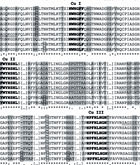Publication
660
J Appl Microbiol. 108 ( 6), 2199 - 2213
, 2010.
DOI: 10.1111/j.1365-2672.2009.04623.x
|
|
|
|
|
 |
High redox potential laccases from the ligninolytic fungi pycnoporus coccineus and pycnoporus sanguineus suitable for white biotechnology: from gene cloning to enzyme characterization and applications. |
|
|
|
|
|
E. Uzan, P. Nousiainen, V. Balland, J. Sipila, F. Piumi, D. Navarro, M. Asther, E. Record and A. Lomascolo
UMR 1163 Biotechnologie des Champignons Filamenteux INRA-Universités de Provence et de la Méditerranée, ESIL, Case 925, Marseille Cedex, France - University of Helsinki, Department of Chemistry, Laboratory of Organic Chemistry, Helsinki, Finland - Laboratoire d'électrochimie moléculaire, Université Paris Diderot, UMR CNRS 7591, Paris Cedex, France - Université de Provence, UMR 1163 Biotechnologie des Champignons Filamenteux INRA, Case 925, Marseille Cedex, France
Aims: Exploitation of natural biodiversity in species Pycnoporus coccineus and Pycnoporus sanguineus to screen for a new generation of laccases with properties suitable for the lignin-processing sector.
Methods and Results: Thirty strains originating from subtropical and tropical environments, mainly isolated from fresh specimens collected in situ, were screened for laccase activity. On the basis of levels of enzyme activity and percentage of similarity between protein sequences, the laccases from strains BRFM 938, BRFM 66 and BRFM 902 were selected for purification and characterization. Each BRFM 938, BRFM 66 and BRFM 902 laccase gene encoded a predicted protein of 518 amino acids; the three deduced proteins showed 68·7–97·5% similarity with other Polyporale laccases. The three laccases (59·5–62·9 kDa with 7–10% carbohydrate content) had high redox potentials (0·72–0·75 V vs normal hydrogen electrode at pH 6), remained highly stable up to 75–78°C and at pH 5–7 mixtures, and were resistant to methyl and ethyl alcohols, acetonitrile and dimethylsulfoxide at concentrations as high as 50% (v/v). The best laccase-1-hydroxybenzotriazole systems permitted almost 100% of various polyphenolic dye decolourization and oxidation of adlerol and veratryl alcohol.
Conclusions: The three laccases showed complementary biochemical features. BRFM 938 laccase had the highest thermo- and pH stability, catalytic efficiency towards 2,2'-azino-bis-[3-ethylthiazoline-6-sulfonate] and resistance to alcoholic solvents. BRFM 66 laccase had the highest rates of dye decolourization and oxidation of nonphenolic compounds.
Significance and Impact of the Study: This study identified P. coccineus and P. sanguineus as outstanding producers of high redox potential laccases, easy to purify and scale-up for industrial production. Three new laccases proved to be suitable models for white biotechnology processes and for further molecular breeding to create a new generation of tailor-made enzymes.
. |

